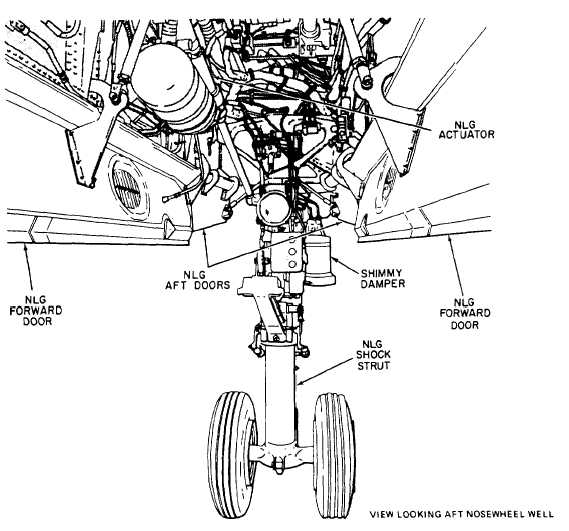Figure 1-13.—Nose gear assembly.
Nose Gear
A typical nose gear assembly is shown in figure
1-13. Major components of the assembly include a
shock strut, drag struts, a retracting mechanism, wheels,
and a shimmy damper.
The nose gear shock strut, drag struts, and retracting
mechanism are similar to those described for the main
landing gear. The shimmy damper is a self-contained
hydraulic unit that resists sudden twisting loads applied
to the nosewheel during ground operation, but permits
slow turning of the wheel. The primary purpose of the
shimmy damper is to prevent the nosewheel from
shimmying (extremely fast left-right oscillations)
during takeoff and landing. This is accomplished by the
metering of hydraulic fluid through a small orifice
between two cylinders or chambers.
Most aircraft are equipped with steerable nose-
wheels and do not require a separate self-contained
shimmy damper. In such cases, the steering mechanism
is hydraulically controlled and incorporates two
spring-loaded hydraulic steering cylinders that, in
addition to serving as a steering mechanism, auto-
matically subdue shimmy and center the nosewheel.
For more information concerning landing gear
components (shock struts, shimmy dampers, power
steering units, and brakes), you should refer to chapter
12 of this TRAMAN.
ARRESTING GEAR
A carrier aircraft is equipped with an arresting hook
for stopping the aircraft when it lands on the carrier. See
figure 1-14. The arresting gear is composed of an
extendible hook and the mechanical, hydraulic, and
pneumatic equipment necessary for hook operation. The
arresting hook on most aircraft is mechanically released,
pneumatically lowered, and hydraulically raised.
The hook is hinged from the structure under the rear
of the aircraft. A snubber, which meters hydraulic fluid
and works in conjunction with nitrogen pressure, is used
to hold the hook down to prevent it from bouncing when
it strikes the carrier deck.
1-14



